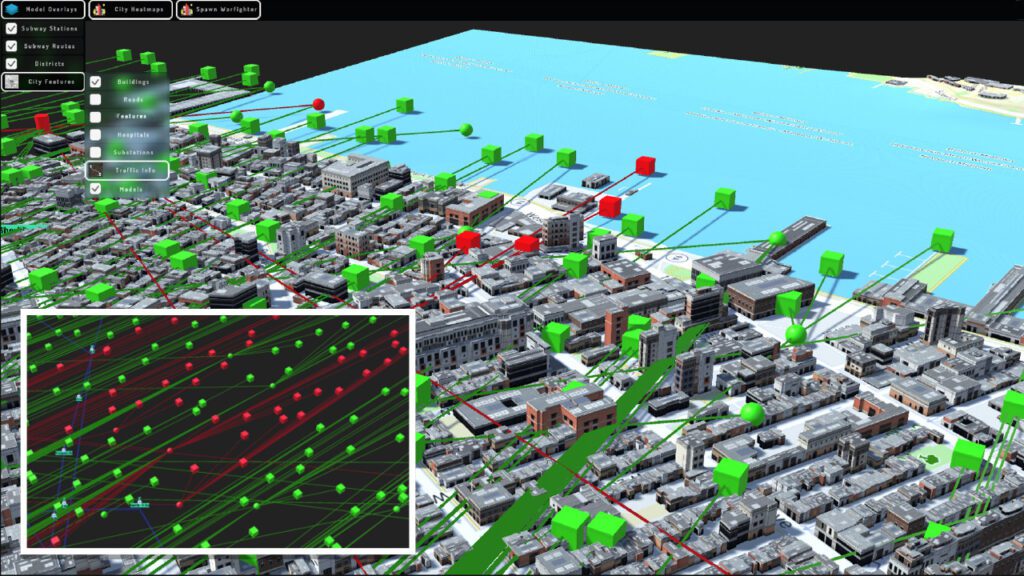MultiMAST
A modeling and simulation toolkit for megacity operations training
A modeling and simulation toolkit for megacity operations training
MultiMAST is a modeling and simulation toolkit that can be used to analyze and plan for different megacity incidents and disaster scenarios. Users expected to benefit from the toolkit include scenario planners, scenario planning trainers, and developers of Live, Virtual & Constructive (LVC) training exercises. LVC developers can use MultiMAST as a construction tool for virtual megacities and their massive numbers of entities.
MultiMAST addresses three main challenges for megacity simulation: meaningful simulation interaction, formidable computational demands, and selection of relevant and effective models.
Megacities present unique challenges for personnel responding to incidents and disasters. Incidents that affect one piece of infrastructure in one part of the city produce changes that cascade through complicated, interdependent systems, such as electricity, traffic, cellular, transportation, and healthcare.
MultiMAST is a modeling and simulation toolkit that can be used to analyze and plan for different megacity incidents and disaster scenarios. Users expected to benefit from the toolkit include scenario planners, scenario planning trainers, and developers of Live, Virtual & Constructive (LVC) training exercises. LVC developers can use MultiMAST as a construction tool for virtual megacities and their massive numbers of entities.
MultiMAST addresses three main challenges for megacity simulation: meaningful simulation interaction, formidable computational demands, and selection of relevant and effective models.
Charles River Analytics developed MultiMAST under a 2-year, million-dollar Phase II SBIR research contract awarded by the US Army. MultiMAST is currently an advanced research stage prototype, available for use in commercial or government partnerships.
How is MultiMAST used?
In MultiMAST, a user selects a base city and then configures it in a Unity-based scenario authoring tool. Users also select and configure different models for the megacity’s subsystems. The software then generates a discrete time simulation matching the user’s choice.
City parameters such as traffic flow can be customized. For your traffic model, configuration parameters include trips per household, the percent of trips to different destinations, and daily trip distributions.
Users interact with a MultiMAST simulation either from a multi-resolution, model-level view or a first-person view. Client-side visualizations are based on the Unity engine for 3D immersion and rendering. The model-level view enables users to see different overlays, such as traffic patterns, electrical grids, and so on. The first-person view provides different levels of fidelity, with the capability for high-fidelity representation.
The simulation populates both static and dynamic entities, where static entities are not updated or changed and dynamic entities are anything that moves or requires updates and modifications. For example, in MultiMAST’s traffic model, households are modeled as static entities whereas residents are modeled as dynamic entities.
Core Capabilities and Features
- Simulates multiple simultaneously interacting large-scale models, which capture the behavior of a variety of systems, including electricity, traffic, cellular, transportation, and healthcare
- Enables simulations with massive numbers of static and dynamics entities, scaling up to the millions for certain cases
- Uses cutting-edge scalable commercial backends that take advantage of geotagged entities and server resources. To maximize performance, these backends delegate simulation tasks that are local within the megacity to computing resources that are local in physical space
- Includes the following model implementations: simple networks, with edges and nodes; flow networks, which transport resources between nodes along edges; radio networks, which transmit data directly between nodes
- Supports agent and entity travel between nodes
- Synchronizes data from different models at geospatial communication points and junction points
- Provides agent and entity rule and behavior customization for different models
- Extracts megacity representation data from public data sources, such as Open-Street Maps
Contact us to learn more about MultiMAST and our other Live, Virtual, and Constructive (LVC) Systems capabilities.
This material is based upon work supported by the Small Business Innovation Research (SBIR) Program through the U.S. Army Contracting Command – Orlando under Contract No. W900KK-18-C-0025. Any opinions, findings and conclusions or recommendations expressed in this material are those of the author(s) and do not necessarily reflect the views of the Small Business Innovation Research (SBIR) Program through the U.S. Army Contracting Command – Orlando.

